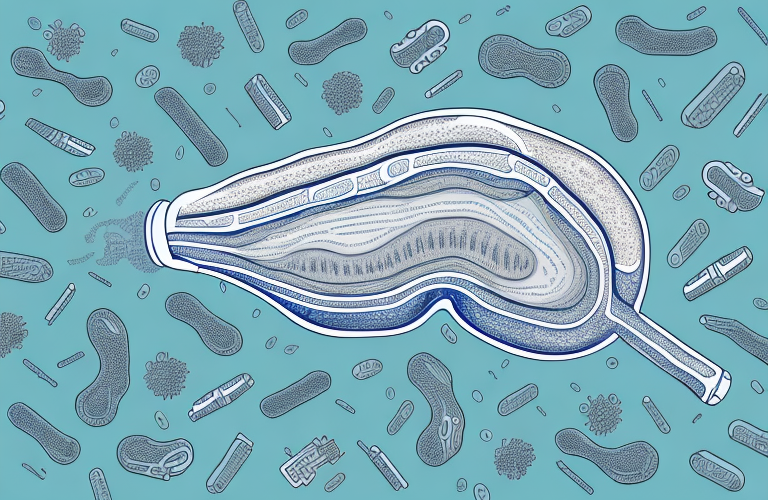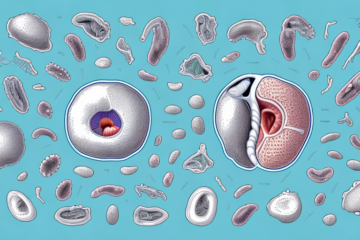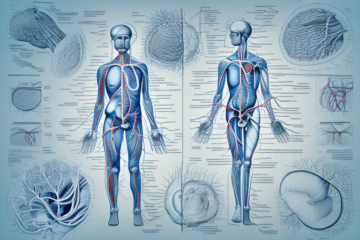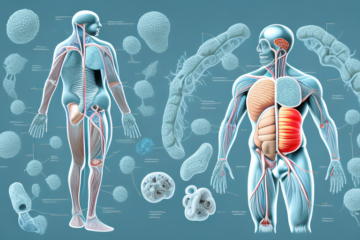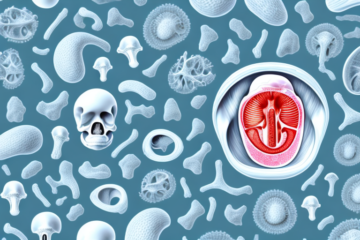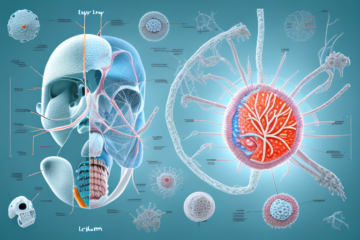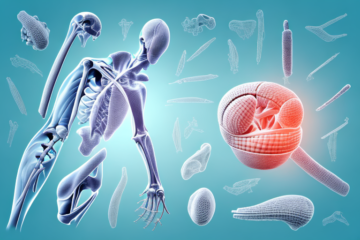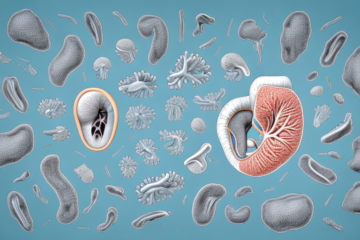The pancreas is a key organ in the digestive system, located behind the stomach in the abdomen. It plays a crucial role in the digestion and regulation of blood sugar in the body. In this article, we will explore the anatomy, functions, and disorders of the pancreas, as well as prevention and treatment strategies for maintaining pancreatic health.
What is the pancreas and where is it located?
The pancreas is a glandular organ that is part of the endocrine and digestive systems. It is situated in the upper left side of the abdomen, behind the stomach, and is connected to the small intestine via a duct called the pancreatic duct.
The pancreas plays a crucial role in regulating blood sugar levels by producing hormones such as insulin and glucagon. Insulin helps to lower blood sugar levels, while glucagon raises them. When the pancreas is not functioning properly, it can lead to conditions such as diabetes.
In addition to its endocrine functions, the pancreas also produces digestive enzymes that help to break down food in the small intestine. These enzymes include amylase, lipase, and protease. Without these enzymes, the body would not be able to properly digest and absorb nutrients from food.
Understanding the role of the pancreas in digestion
The pancreas produces and secretes digestive enzymes that help break down proteins, carbohydrates, and fats in the small intestine. These enzymes are essential for proper digestion and absorption of nutrients from our food. The pancreas also produces bicarbonate, which neutralizes stomach acid as it enters the small intestine. Without the pancreatic enzymes and bicarbonate, digestion would be incomplete and nutrient absorption impaired.
In addition to its role in digestion, the pancreas also plays a crucial role in regulating blood sugar levels. It produces the hormones insulin and glucagon, which work together to maintain a stable level of glucose in the bloodstream. Insulin helps cells absorb glucose from the blood, while glucagon signals the liver to release stored glucose when blood sugar levels drop too low. Dysfunction of the pancreas, such as in the case of diabetes, can lead to imbalances in blood sugar levels and a range of health complications.
How does the pancreas produce insulin and regulate blood sugar levels?
The pancreas plays a vital role in regulating blood sugar levels in the body. It produces and secretes two hormones, insulin and glucagon, that are involved in maintaining balanced blood sugar levels. Insulin helps the cells in our body absorb glucose from the bloodstream, while glucagon signals the liver to release stored glucose back into the bloodstream when blood sugar levels are low. This delicate balance is crucial for energy production and overall health.
The pancreas produces insulin in response to rising blood sugar levels after a meal. Specialized cells in the pancreas, called beta cells, sense the increase in blood sugar and release insulin into the bloodstream. Insulin then travels to cells throughout the body, where it binds to receptors on the cell surface and signals the cell to take up glucose from the bloodstream. This process helps to lower blood sugar levels and provide energy to the body’s cells.
The connection between pancreatic diseases and diabetes
Pancreatic disorders can affect insulin production and lead to diabetes, a chronic condition characterized by high blood sugar levels. Type 1 diabetes is caused by an autoimmune reaction that destroys the insulin-producing cells in the pancreas, while Type 2 diabetes occurs when the body becomes resistant to insulin. Chronic pancreatitis, pancreatic cancer, and pancreatic surgery can also damage the pancreas and reduce insulin production, leading to diabetes.
Recent studies have shown that there may be a link between pancreatic diseases and the development of other health conditions, such as heart disease and certain types of cancer. This is because the pancreas plays a crucial role in regulating the body’s metabolism and maintaining overall health. When the pancreas is not functioning properly, it can lead to a range of health problems beyond just diabetes.
It is important for individuals with pancreatic diseases to work closely with their healthcare providers to manage their condition and reduce the risk of developing other health complications. This may involve making lifestyle changes, such as adopting a healthy diet and exercise routine, as well as taking medications or undergoing surgery to treat the underlying pancreatic disorder.
Common symptoms of pancreatic disorders to watch out for
The symptoms of pancreatic disorders can be vague and difficult to diagnose in the early stages. Some common symptoms include persistent abdominal pain, nausea, vomiting, unexplained weight loss, yellowing of the skin or eyes, and changes in bowel movements. It is important to seek medical attention if you experience any of these symptoms to rule out any serious pancreatic disorders.
Other symptoms that may indicate a pancreatic disorder include fever, chills, and sweating. These symptoms may be present in cases of acute pancreatitis, which is a sudden inflammation of the pancreas. In chronic pancreatitis, symptoms may include indigestion, bloating, and fatty stools.
In some cases, pancreatic disorders may not cause any symptoms until they have progressed to an advanced stage. This is why it is important to have regular check-ups with your doctor, especially if you have a family history of pancreatic disorders or other risk factors such as smoking or obesity.
Diagnosing pancreatic diseases: Tests and procedures used
To diagnose pancreatic diseases, doctors use a combination of physical exams, blood tests, imaging tests, such as CT scans or MRIs, and endoscopy to evaluate the pancreas. Biopsies can be taken during an endoscopy to determine if there are any cancerous or pre-cancerous cells present. In some cases, laparoscopic surgery may be necessary to obtain a tissue sample for testing.
One of the most common blood tests used to diagnose pancreatic diseases is the pancreatic enzyme test. This test measures the levels of enzymes produced by the pancreas, such as amylase and lipase. Elevated levels of these enzymes can indicate inflammation or damage to the pancreas.
In addition to these tests, doctors may also use genetic testing to diagnose certain types of pancreatic diseases, such as hereditary pancreatitis. This involves analyzing a patient’s DNA to look for mutations or changes in genes that are associated with pancreatic disease.
Treatment options for pancreatic cancer, inflammation, and other disorders
The treatment of pancreatic disorders depends on the severity and type of condition present. Pancreatic cancer may require surgery, chemotherapy, or radiation therapy, while chronic pancreatitis may be treated with medications and lifestyle changes. Diabetes caused by pancreatic disorders may require insulin therapy, medication, and lifestyle changes. In rare cases, a pancreas transplant may be necessary to treat chronic or severe pancreatic disorders.
It is important to note that early detection and diagnosis of pancreatic disorders can greatly improve treatment outcomes. Regular check-ups and screenings can help identify any potential issues before they become more serious. Additionally, maintaining a healthy diet and lifestyle can also help prevent the development of pancreatic disorders.
Research is ongoing to develop new and more effective treatments for pancreatic disorders. Clinical trials are available for patients who may be interested in participating in these studies. It is important to discuss all treatment options with a healthcare provider to determine the best course of action for each individual case.
Lifestyle changes to maintain a healthy pancreas
Several lifestyle changes can help maintain a healthy pancreas, such as quitting smoking, moderating alcohol consumption, eating a healthy diet rich in fruits and vegetables, and maintaining a healthy weight through regular exercise. These lifestyle changes can also reduce the risk of developing pancreatic disorders such as pancreatitis and pancreatic cancer.
In addition to the above mentioned lifestyle changes, managing stress levels is also important for maintaining a healthy pancreas. High levels of stress can lead to inflammation in the pancreas, which can cause damage over time. Practicing relaxation techniques such as meditation, yoga, or deep breathing exercises can help reduce stress levels and promote pancreatic health.
It is also important to stay hydrated to maintain a healthy pancreas. Drinking plenty of water helps to flush out toxins and waste products from the body, including the pancreas. Dehydration can lead to the formation of pancreatic stones, which can cause blockages and inflammation in the pancreas. Aim to drink at least 8-10 glasses of water per day to keep your pancreas healthy.
Prevention strategies for pancreatic diseases
There are several prevention strategies that can help reduce the risk of developing pancreatic disorders. These include maintaining a healthy weight, quitting smoking, moderating alcohol consumption, and consuming a high-fiber, low-fat diet rich in fruits and vegetables. Regular exercise and stress management techniques such as meditation and yoga can also reduce the risk of developing pancreatic disorders.
In addition to these prevention strategies, it is important to be aware of the signs and symptoms of pancreatic disorders. These can include abdominal pain, nausea, vomiting, and changes in bowel movements. If you experience any of these symptoms, it is important to speak with your healthcare provider to determine the underlying cause and receive appropriate treatment.
The link between diet and pancreatic health
Diet plays a crucial role in maintaining pancreatic health. A diet high in red and processed meats, saturated fats, and sugar can increase the risk of developing pancreatic disorders. A diet rich in fiber, fruits, vegetables, and whole grains can reduce the risk. Additionally, studies suggest that certain foods such as turmeric, ginger, and green tea may have anti-inflammatory properties that can support pancreatic health.
It is important to note that alcohol consumption can also have a negative impact on pancreatic health. Heavy alcohol consumption can lead to chronic pancreatitis, a condition in which the pancreas becomes inflamed and damaged over time. This can lead to a variety of symptoms such as abdominal pain, nausea, and vomiting. Therefore, it is recommended to limit alcohol consumption to promote pancreatic health.
Pancreatic disease research: Current trends and breakthroughs
Research is ongoing in the field of pancreatic disorders, with a focus on developing new treatments and improving early detection methods. Breakthroughs in precision medicine, immunotherapy, and genetic testing are offering new hope for patients with pancreatic cancer. Additionally, researchers are exploring the potential of stem cell therapy for regenerating damaged pancreatic tissue.
Recent studies have also shown promising results in the use of artificial intelligence (AI) for early detection of pancreatic diseases. Machine learning algorithms are being developed to analyze medical images and identify early signs of pancreatic cancer, which could lead to earlier diagnosis and better outcomes for patients. This technology has the potential to revolutionize the field of pancreatic disease research and improve patient outcomes.
Support resources for patients with pancreatic disorders
Pancreatic disorders can have a significant impact on a patient’s physical and emotional wellbeing. Several support resources are available for patients with pancreatic disorders, such as support groups, counseling services, and educational resources. Patients can also connect with advocacy organizations and research institutes to learn about clinical trials and treatment options.
It is important for patients with pancreatic disorders to have a strong support system. Family and friends can play a crucial role in providing emotional support and helping patients navigate the healthcare system. Additionally, healthcare providers can refer patients to social workers or patient navigators who can assist with accessing resources and coordinating care. By utilizing these support resources, patients with pancreatic disorders can improve their quality of life and better manage their condition.
Frequently asked questions about the pancreas
Some common questions about the pancreas include:- What is the function of the pancreas? – What are the symptoms of pancreatic disorders? – How are pancreatic disorders diagnosed and treated? – What are the risk factors for developing pancreatic disorders? – Can diet and lifestyle changes improve pancreatic health? Consulting with a doctor or healthcare provider can provide more information and clarification regarding these questions.
Overall, the pancreas is a vital organ that plays a crucial role in maintaining our health and wellbeing. Understanding the anatomy, functions, and disorders of the pancreas can help us take proactive steps to maintain pancreatic health and reduce the risk of developing pancreatic diseases.
One of the most common pancreatic disorders is pancreatitis, which is inflammation of the pancreas. This condition can be caused by a variety of factors, including alcohol consumption, gallstones, and high levels of triglycerides in the blood. Symptoms of pancreatitis include severe abdominal pain, nausea, vomiting, and fever. Treatment for pancreatitis typically involves hospitalization, pain management, and addressing the underlying cause of the inflammation.
In addition to pancreatitis, pancreatic cancer is another serious condition that can affect the pancreas. This type of cancer is often difficult to detect in its early stages, and symptoms may not appear until the cancer has spread to other parts of the body. Risk factors for pancreatic cancer include smoking, obesity, and a family history of the disease. Treatment for pancreatic cancer may involve surgery, chemotherapy, and radiation therapy.

